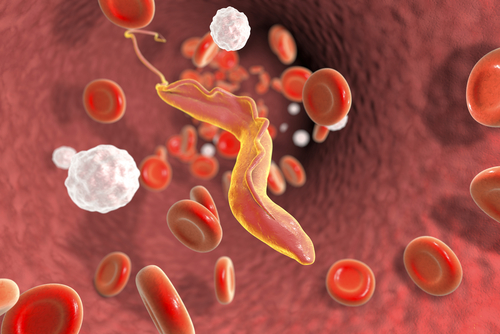Chagas disease, a potentially life-threatening illness caused by protozoan parasite Trypanosoma cruzi
UNI May 21, 2018
Chagas disease, also known as American trypanosomiasis, is a potentially life-threatening illness caused by the protozoan parasite Trypanosoma cruzi (T. cruzi).

About 6 million to 7 million people worldwide are estimated to be infected with Trypansosoma cruzi, the parasite that causes Chagas disease. Chagas disease is found mainly in endemic areas of 21 Latin American countries, where it is mostly vector-borne transmitted to humans by contact with faeces or urine of triatomine bugs, known as 'kissing bugs', among many other names, depending on the geographical area.
The cost of treatment for Chagas disease remains substantial. In Colombia alone, the annual cost of medical care for all patients with the disease was estimated to be about US$ 267 million in 2008. Spraying insecticide to control vectors would cost nearly US$ 5 million annually – less than 2% of the medical care cost. Chagas disease is named after Carlos Ribeiro Justiniano Chagas, a Brazilian physician and researcher who discovered the disease in 1909.
Chagas disease occurs principally in the continental part of Latin America, and not in the Caribbean isles. In the past decades, however, it has been increasingly detected in the United States of America, Canada, and many European and some Western Pacific countries. This is due mainly to population mobility between Latin America and the rest of the world.
Chagas disease presents itself in 2 phases. The initial acute phase lasts for about 2 months after infection. During the acute phase, a high number of parasites circulate in the blood but in most cases symptoms are absent or mild and unspecific. In less than 50 per cent of people bitten by a triatomine bug, characteristic first visible signs can be a skin lesion or a purplish swelling of the lids of one eye. Additionally, they can present fever, headache, enlarged lymph glands, pallor, muscle pain, difficulty in breathing, swelling, and abdominal or chest pain.
During the chronic phase, the parasites are hidden mainly in the heart and digestive muscles. Up to 30 per cent of patients suffer from cardiac disorders and up to 10 per cent suffer from digestive (typically enlargement of the oesophagus or colon), neurological or mixed alterations. In later years the infection can lead to sudden death due to cardiac arrhythmias or progressive heart failure caused by the destruction of the heart muscle and its nervous system.
-
Exclusive Write-ups & Webinars by KOLs
-
Daily Quiz by specialty
-
Paid Market Research Surveys
-
Case discussions, News & Journals' summaries